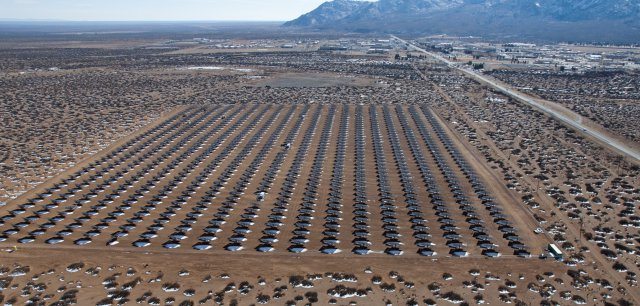The U.S. Army dedicated its largest solar photovoltaic system at White Sands Missile Range, Jan. 16, in a ceremony led by Brig. Gen. Gwen Bingham, White Sands commander, joined by Katherine Hammack, assistant secretary of the Army for Installations, Energy and Environment.
“I came here about four months ago talking about how White Sands is a national treasure and now we can feel proud that we’re really on the environmental edge,” Bingham said. “It takes passion to do something like this. I’m just excited about the journey that will lie ahead.”
Developed in coordination with the U.S. Army Engineering and Support Center in Huntsville, Ala., Siemens Government Technologies, Inc., and Bostonia, the over-four-megawatt White Sands Missile Range solar energy system will generate about 10 million kilowatt-hours of clean electricity annually, and provide an estimated annual savings of $930,000.
Complemented by a 375 kW solar carport, the solar array deployed at White Sands will supply about 10 percent of the total power used at the installation and reduce carbon emissions by 7,400 tons per year. Featuring Solaria’s proprietary technology, the 4.1 MW ground-mounted tracking system is also the world’s largest low-concentration photovoltaic solar power plant.
“This is an exciting project for the U.S. Army,” said Garrison Commander Col. Leo Pullar. “A sunny location like New Mexico provides an ideal site for solar power. This project illustrates the U.S. Army’s commitment to going green, our focus on operating on net zero energy, and doing what we can to help protect the environment.”
“We are very pleased to be inaugurating this milestone photovoltaic installation,” said Will Irby, Huntsville Center program manager. “We’re extremely grateful to the entire team, comprised of the staff from White Sands Missile Range, Huntsville Center, Siemens, their subcontractor Solaria Corporation and Bostonia, working under the leadership of Brig. Gen. Gwen Bingham and Col. Leo Pullar. Everyone has done an outstanding job to bring this project to fruition.”
“Siemens is committed to helping the Department of Defense achieve unprecedented levels of energy efficiency, security and independence,” said Judy Marks, president and CEO of Siemens Government Technologies, Inc. “Through this Energy Savings Performance Contract, the value of sustainability is measured not just in terms of financial benefits, but benefits to maintaining mission readiness, and the preservation of options for the Army’s future.”
“The Department of Defense is deploying renewable energy and reducing its reliance on fossil fuel resources. This solar-energy system demonstrates that the U.S. government’s goals for enhancing security through energy independence can be met both economically and practically when the public and private sectors work together,” said Dan Shugar, CEO of Solaria Corporation.
Construction of the solar power plant began in April 2012 and was completed in December 2012. The ground-mounted single-axis Solaria tracking system follows the sun across the sky, increasing energy yield by up to 30 percent over fixed systems. All energy generated from the project will be consumed by onsite operations.
“(As a nation) we are consuming more energy and have an aging infrastructure, it is the responsibility of the Army to help reduce the stress and strain on those power lines and we do this in partnership with the utilities. The power lines end here,” Hammack said. “There’s no better support from the community than here at White Sands and New Mexico. You have a lot of natural resources that contribute to the future of this state”
The $16.8 million solar PV system was the primary component of an Energy Savings Performance Contract implemented by the Building Technologies Division of Siemens Industry, Inc. Under the contract task order, Siemens will maintain and operate the equipment and will sell the energy it generates to White Sands Missile Range at the same rate they are currently paying the local utility company.
The Army will own the renewable energy credits, or RECs, and use them toward meeting federal renewable energy mandates.
The project supports President Barack Obama’s directive that federal agencies use Energy Savings Performance Contracts to make $2 billion worth of energy efficiency upgrades over the next year, as well as supporting the Army’s renewable energy goals.










